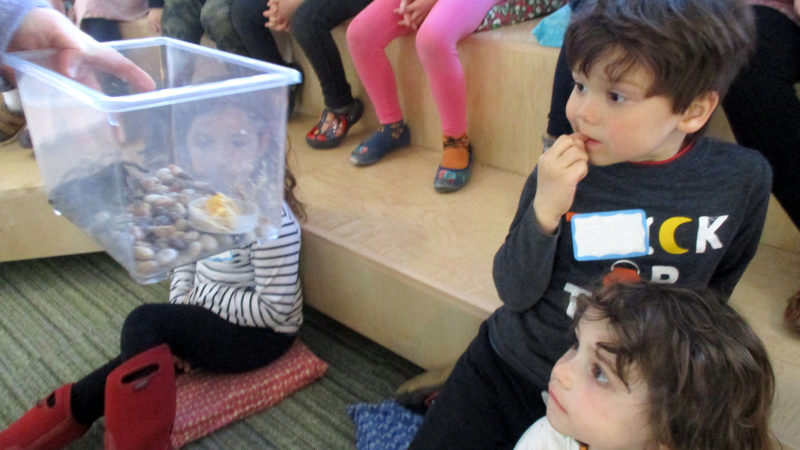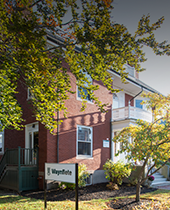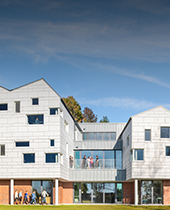Emergent curriculum in Early Childhood: a gateway to community collaboration
Waynflete’s Early Childhood program is inspired by Reggio Emilia and embraces an emergent or “negotiated” curriculum. We never study the same thing twice. We don’t know when we may need a dock (study of lobster boats and lobstering), a squid to dissect (study of cephalopods), or—for this year’s study of the desert—saguaro cacti.
 We began our study of the desert in late February after students expressed an interest in spiders and succulents. The children quickly became enchanted with the saguaro cactus. We asked our friends in Maintenance to help make an armature so we could have some life-sized cacti in our desert. The result—created by Bob Reinhard—was beyond our dreams. An all-school email resulted in rugs for sand and burlap for displays. 4-5 teacher Vanessa Churchill shared a coyote skull and cacti ribs.
We began our study of the desert in late February after students expressed an interest in spiders and succulents. The children quickly became enchanted with the saguaro cactus. We asked our friends in Maintenance to help make an armature so we could have some life-sized cacti in our desert. The result—created by Bob Reinhard—was beyond our dreams. An all-school email resulted in rugs for sand and burlap for displays. 4-5 teacher Vanessa Churchill shared a coyote skull and cacti ribs.
 Our friends in the Science department also stepped up, as they so often do. Neil Rice gave a presentation on adaptations, showing students how jack rabbits use their big ears to hear predators and stay cool. With Neil’s help, the students developed a hypothesis that a desert is cooler underground than at the surface. A quick experiment (shining a lamp on a bucket of sand and measuring the temperature) helped support the hypothesis.
Our friends in the Science department also stepped up, as they so often do. Neil Rice gave a presentation on adaptations, showing students how jack rabbits use their big ears to hear predators and stay cool. With Neil’s help, the students developed a hypothesis that a desert is cooler underground than at the surface. A quick experiment (shining a lamp on a bucket of sand and measuring the temperature) helped support the hypothesis.
A more extensive experiment tested the hypothesis the saguaro cactus’s waxy coating helps keep water in. Students modeled a saguaro using wetted rolls of paper and wax paper. “The best part was that the experiment failed to give us the results we expected,” said Neil. “The kids came up with their own ideas about why it didn’t work. They conducted a revised experiment the next day that better modeled the saguaro. They really embraced scientific thinking!”
 Grandparent Fred Miller brought in some of his cacti collection and shared his passion with us. Lower School Librarian Laurel Daly found and ordered books. Skillins, a local greenhouse, welcomed us all in to see and purchase some succulents and cacti for our classroom. We loved the smell of plants and earth in late February!
Grandparent Fred Miller brought in some of his cacti collection and shared his passion with us. Lower School Librarian Laurel Daly found and ordered books. Skillins, a local greenhouse, welcomed us all in to see and purchase some succulents and cacti for our classroom. We loved the smell of plants and earth in late February!
 Students became curious about how tall the saguaro really are. Our beloved bus driver Bill Fenderson brought in his laser measuring device. Graciously, and with gumption, Bill laid down on the floors of the Lower School lobby, the gym, Sills Hall, and the Emery Atrium to measure. (For those who are curious: the Lower School lobby ceiling measures in at a height of 21 feet. Sills is 22 feet, the gym is 25 feet, and the Emery Atrium is 46 feet, which is just about the height of a tall saguaro!)
Students became curious about how tall the saguaro really are. Our beloved bus driver Bill Fenderson brought in his laser measuring device. Graciously, and with gumption, Bill laid down on the floors of the Lower School lobby, the gym, Sills Hall, and the Emery Atrium to measure. (For those who are curious: the Lower School lobby ceiling measures in at a height of 21 feet. Sills is 22 feet, the gym is 25 feet, and the Emery Atrium is 46 feet, which is just about the height of a tall saguaro!)
Our study continues, as does our collaboration. Neve, one of our 2-3 buddies, came and shared her experiences of living near the desert in Jordan. We have recently turned our attention to the animals in the desert, especially the rattlesnake and tarantula. Middle School teacher Kate Ziminsky visited the class and helped students learn more about the adaptations creatures make in order to survive in desert habitats—and how they find food in extreme conditions. Students had the opportunity to see meet Rosie, a live Chilean Rose Haired Tarantula. They also examined a coyote pelt, great horned owl parts, a snake skin, the shell of a nine banded armadillo, and a mounted brown bat.
We cannot wait to see what happens next. Perhaps a visit to the Desert of Maine!




